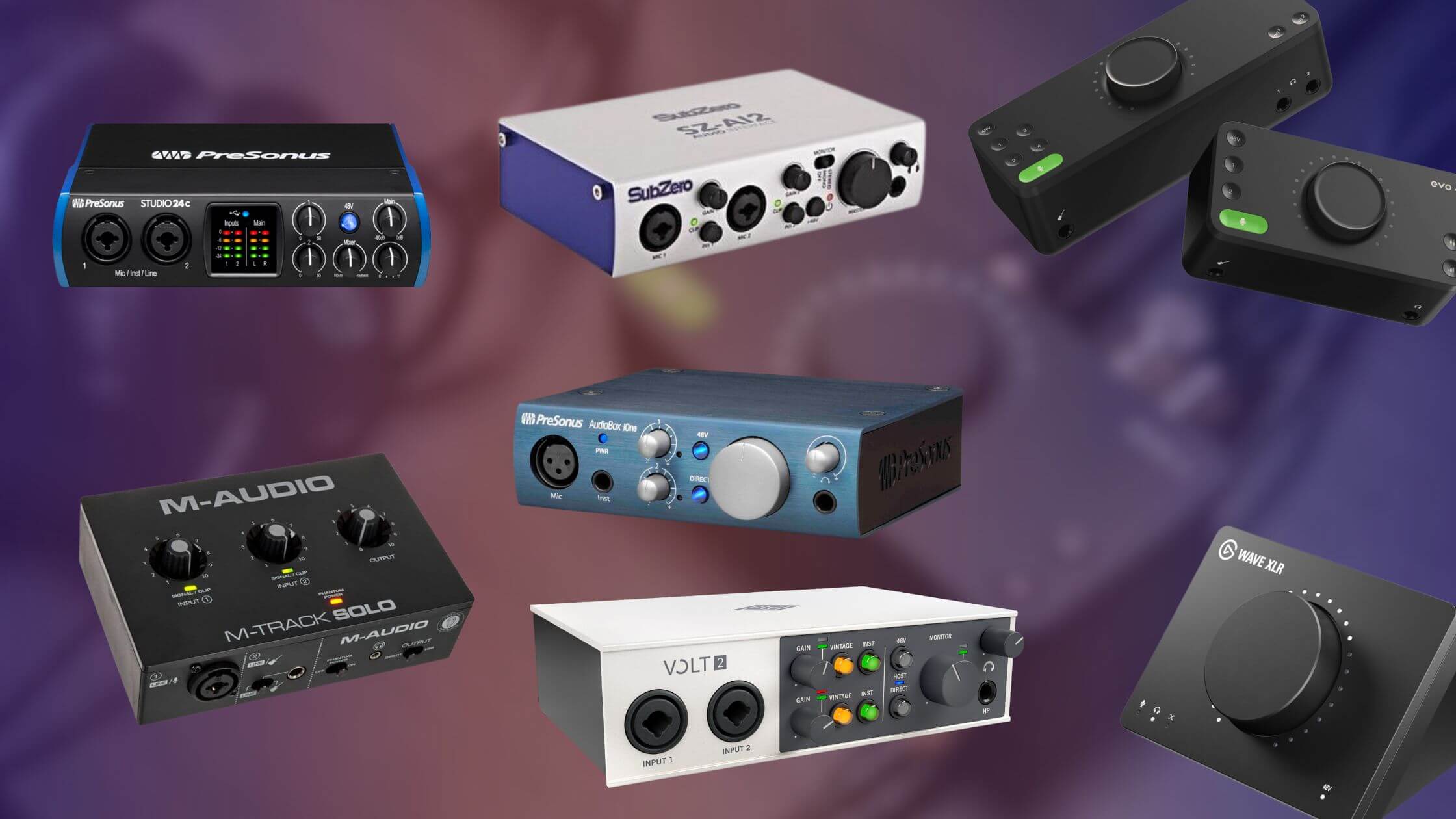Top ten audio interfaces 2024: best affordable interfaces for your recording setup
Finding the affordable audio interface for you depends on your needs. Whether you’re producing music, recording guitars and vocals via microphone or electronic instruments, this list of low price audio interfaces is packed with feature-rich interfaces.
Producers, singers & musicians – finding the best audio interface with your small budget is pretty daunting. The market is packed with audio interfaces that all seem to do the same thing, give or take a feature here or there.
So, the real question to ask yourself is how many features you can get for a low price. Trust me, there are a few options. Whether you’re looking for a new USB interface to upgrade your home studio or simply record your instrument, you’ll find the affordable audio interface you’re looking for below.
- Audient ID4 mkII
- Audient EVO 4 USB
- PreSonus Studio 24C
- SubZero AI2
- EVO Audient 8 USB
- Solid State Logic SSL 2+
- PreSonus AudioBox iOne
- Universal Audio Volt 2
- Elgato Wave XLR
- M-Audio M-Track Solo
Audient ID4 MKII – $120 – best overall affordable audio interface
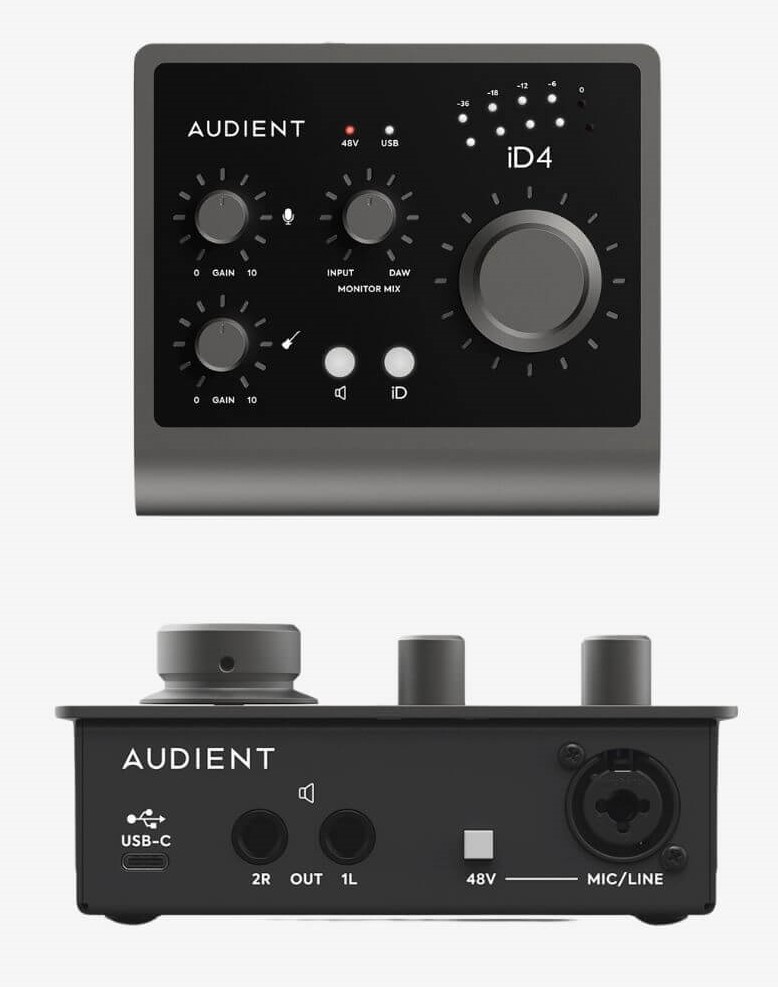
- 2 in / 2 out
- Up to 24-bit / 92 kHz recording
- macOS, Windows, iOS
World-renowned for delivering professional audio performance in a compactly sleek interface for desktops, the thoughtfully engineered ID4 is designed for musicians to record vocals and instruments at home conveniently, no matter the space size.
At its heart lies the reputable high-grade Audient Console Mic Preamps offering wide bandwidth, flexible topology and clean, punchy sound. While its inherent noise floor is 30,000 times quieter than the signal level, the preamp adds a touch of analogue warmth to your signal with up to 58 dB of mic input gain and 48dB for line inputs.
Coupled with ID4 mk2’s class-leading converters, Audient’s mic preamps guarantee a professional recording. There’s plenty of resolution, although the Scarlett Solo is $70 cheaper and offers a 192 kHz sample rate as opposed to the ID4’s 96 kHz. Although not meagre, some artists may prefer higher resolution for a lower price.
Anyhow, there’s plenty of dynamic range and bandwidth for you to sing into a mic like you mean it while recording your instrument via the JFET instrument input. The ID4’s ultra-low latency facilitates seamless monitoring while recording, and you can blend between your inputs and computer audio in the 1/4″ headphone input. Being compatible with iOS devices makes the interface fully portable too… unless you’re an Android user like me.
Audient has furthermore provided a virtual scroll wheel that augments workflows by providing hands-on control over DAW, instrument and plugin parameters. The ID4 is powered via USB-C, and it’s bundled with free software including Cubase LE and Cubasis LE for iOS, along with industry-leading virtual instruments and plugins.
Audient EVO 4 USB – $130 – best for hassle-free recording

- 2 in / 2 out
- 24-bit / 96Khz recording
- SmartGain
Despite its popularity, since the EVO series joined the block Audient’s flagship ID series has taken a backseat.
The affordable EVO interface in the series, the EVO 4, has been a game-changer for capturing studio-quality recordings at home, on a budget, with AI-powered, award-winning EVO preamps and high-quality conversions. Coupled with its intelligent mic preamps is a JFET Instrument input for high-impedance line instruments!
Combining analogue warmth with digital accuracy, the EVO preamps are the biggest, heavy-hitting selling point for Audient’s new flagship affordable interface. Intelligent gain control accommodates headroom by analysing, adjusting, and setting gain levels in under 20 seconds before you hit record.
Meanwhile, 58dB of mic gain captures your performance plenty loud, free of noticeable and unwanted noise, while 113dB of dynamic range provides headroom for an expressive performance.
With its AI-powered features, low latency and audio resolution specs all powered over USB-C, the EVO 4 is a fully portable, flexibly reliable companion for musicians.
PreSonus Studio 24C – $150 – best for MIDI
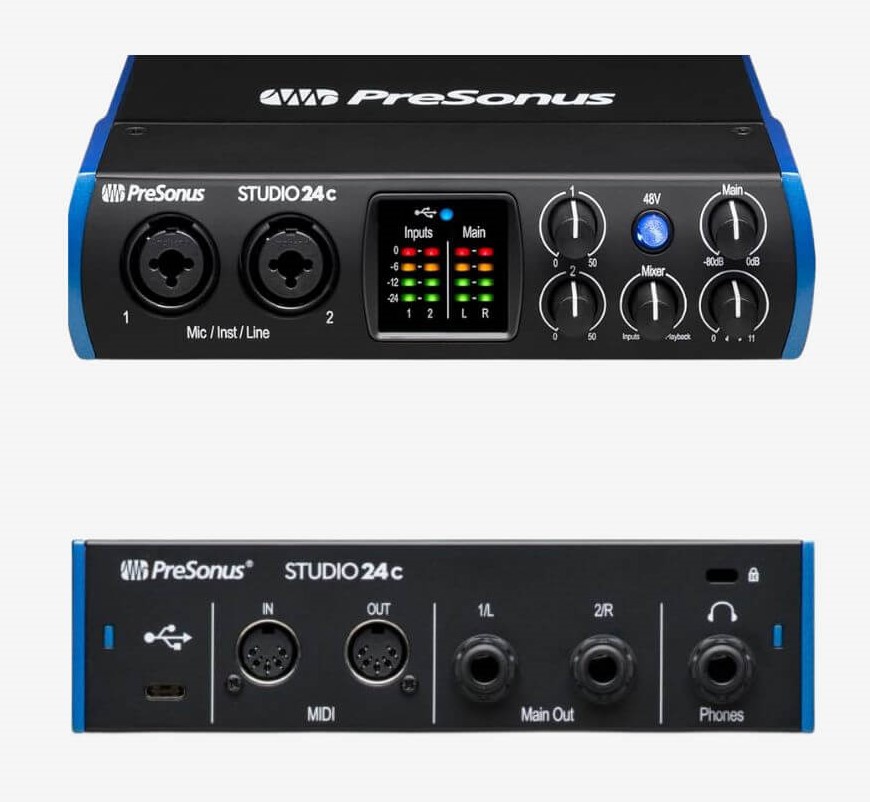
- 2 in / 2 out
- 24-bit / 192 kHz recording
- MIDI In/Out
Next is another family favourite, the PreSonus Studio 24C audio interface. It’s long been a go-to solution for many looking for professional sound from home, loved by seasoned musicians and beginners. And its reputation is well-deserved, thanks to its excellent microphone and instrument preamps, as well as its intuitive controls.
PreSonus provides 2 XLR / TRS combo inputs for line and mic signals, as well as MIDI in/out. The Studio 24c furthermore offers a high-power headphone output for low-latency monitoring, capable of sending signals to headphones with high resistance (ohms).
The interfaces’ front-panel level controls are accompanied by a 4 ladder-style LED level meter and a mixer knob that’s mappable to parameters in your DAW. Meanwhile, its bus power with USB-C compatibility makes it accessible for any musician at any level looking for highly detailed recordings (with up to 24-bit /192 kHz audio resolution).
The Studio 24c is compatible with macOS, Windows, iOS, and iPadOS, and is, therefore, a versatile option for various setups. You’ll also get Studio Magic Software Suite which comprises tutorials, sound libraries, virtual instruments, and effects plugins. It also comes bundled with PreSonus’ award-winning Studio One Artist software, offering a complete recording solution right out of the box.
Solid State Logic SSL 2+ – $180 – 4K Legacy preamps for guitarists
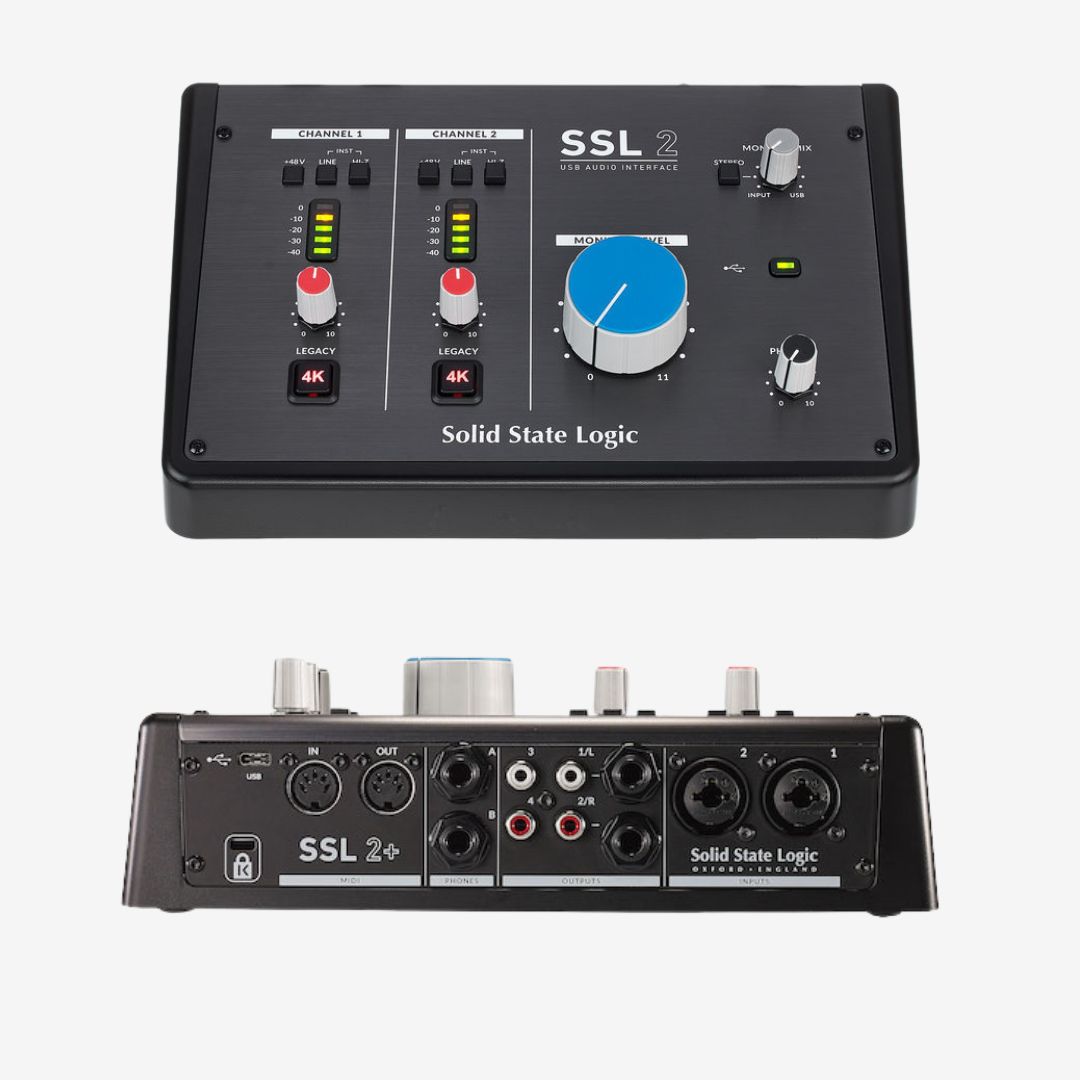
- 2 in / 4 out
- MIDI In/Out
- Legacy 4K analogue colour enhancement
Another well-known, the SSL 2+ is a super-comprehensive recording solution for media and music production. Although it’s probably the oldest interface on the list, it nevertheless packs a punch… and its age does render its awesome features at a lower retail value.
SSL’s 2 in, 2 out interface offers two SSL preamps, 24-bit / 192kHz AD/DA signal conversion, and a “Legacy 4K” analog colour enhancement inspired by classic SSL consoles. Meanwhile, 62dB of input gain provides plenty of headroom for recording electric instruments and microphone tracks.
MIDI In/Out ports on the back provide connectivity to more hardware, providing future proof for producers and electronic artists who want to expand their setups later. Via a firmware update, podcasters can also use SSL’s loopback feature and capture computer audio during online calls.
Furthermore, collaborating with other artists is easy thanks to two balanced monitor outputs and a Monitor Mix Control, blending between computer audio & any inputs. Heck, there are even RCA outputs for HiFi connections
The SSL Production Pack is bundled with the interface and promises to augment your workflow by providing virtual instruments, plugins, samples and Ableton Live Lite.
SubZero AI2 – $90 – best for beginners
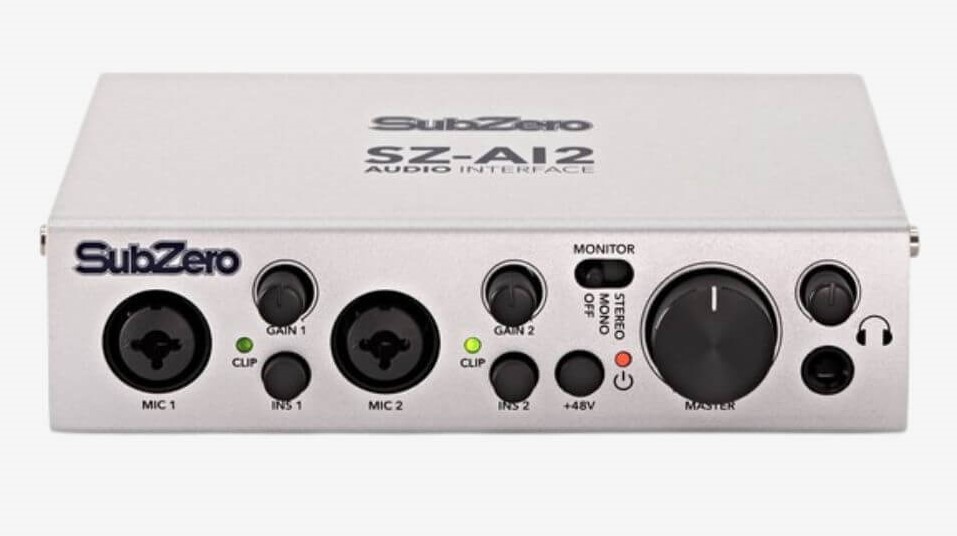
- 2 in / 2 out
- 24-bit / 96kHz recording
- Stereo and mono playback
It’s time we discuss a lesser-known player – an underdog if you like. The SubZero AI2 USB is the most affordable audio interface for songwriters and bedroom artists on our list, and it packs a weighty punch.
While boasting two studio-grade XLR/ 1/4″ combo inputs with phantom power, the AI2’s ultra-transparent preamps will preserve the integrity of your original signal with no colouration. The interface offers 24-bit / 96kHz recording too, meaning you can apply heavy time & pitch-based edits to your recorded signal before it distorts.
Therefore, the AI2 brings studio-quality audio to bedrooms everywhere, and the AI2 also offers an impedance switch for its preamps allowing you to accommodate different recording equipment.
The AI2 is super accessible with its bus-powered plug-and-play USB 2.0 port, requiring no drivers or installers. As a result, anyone new to recording gets a hassle-free experience whenever creativity strikes. SubZero’s affordable interfaces’ user-friendly design even offers family favourite LEDs for visual cues suggesting your input signal is too hot.
The powerful output section of the AI2 meanwhile offers both stereo and mono playback, facilitating phase checking and mix translation which some more expensive interfaces don’t offer. Consequently, the AI2 is easily the most versatile affordable audio interface and is the complete package, offering professional-grade features for a premium recording experience.
PreSonus AudioBox iOne – $70 – best for recording guitar under $100

- 2 in / 2 out
- 24-bit / 96 kHz recording
- macOS, Windows, iOS
PreSonus’s compact and versatile AudioBox iOne is for anyone looking for professional audio while prioritising portability. The AudioBox iOne is another oldie yet goldie, but the interface can simultaneously capture a microphone and an electric instrument.
Powered by USB 2.0, the iOne is equipped with powerful mic preamps offering high headroom and +48V phantom power. The iOne’s single instrument and XLR microphone inputs are converted at 24-bit / up to 98 kHz, providing higher than studio-grade resolution.
One balanced ¼-inch TRS outputs sit on the back while a stereo headphone jack is on the front, and the onboard analog mixer provides zero-latency monitoring via the ‘Direct’ button.
The AudioBox iOne furthermore comes bundled with Studio One Artist DAW for macOS and Windows, providing the recording tools you need out of the box. You’ll even get access to Studio Magic’s Software Suite featuring over $1,000 worth of plugins, loops, virtual instruments, effects, and tutorials!
Universal Audio Volt 2 – $100 – best for analog colouration
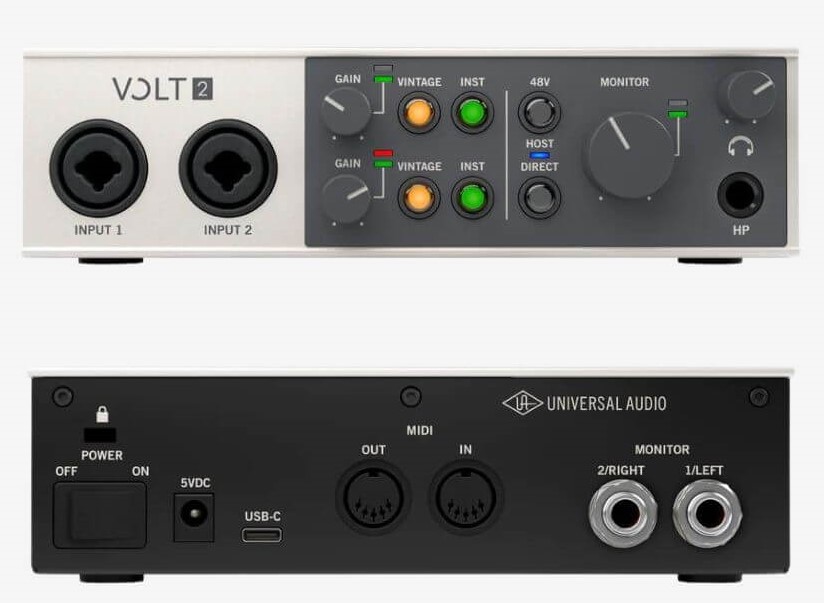
- 2 in / 2 out
- Vintage Mic Preamp mode
- macOS, Windows, iOS
Universal Audio’s popular Volt 2 USB came to power a couple of years ago and we haven’t looked back since. It’s extremely pretty and provides plenty of functionality for creative collaboration, offering awesome sound for musicians, producers and creators.
Offering 2 inputs & 2 outputs, Volt 2 provides zero-latency monitoring with its stereo headphone output. With its Vintage Mic Preamp mode, you can capture vocals or instrument recordings with the iconic sound of the Universal Audio 610 tube preamp (known for its rich and full sound), adding desirable analog character.
With its solid plastic construction and vintage-inspired design, Volt 2 is built to withstand years of use, making it a reliable choice for any home or mobile recording setup. Additionally, Volt 2 comes with a curated suite of audio software, including titles from Ableton, Melodyne, Virtual Drummer, Marshall, Ampeg, and more!
Elgato Wave XLR – $100 – best for travel
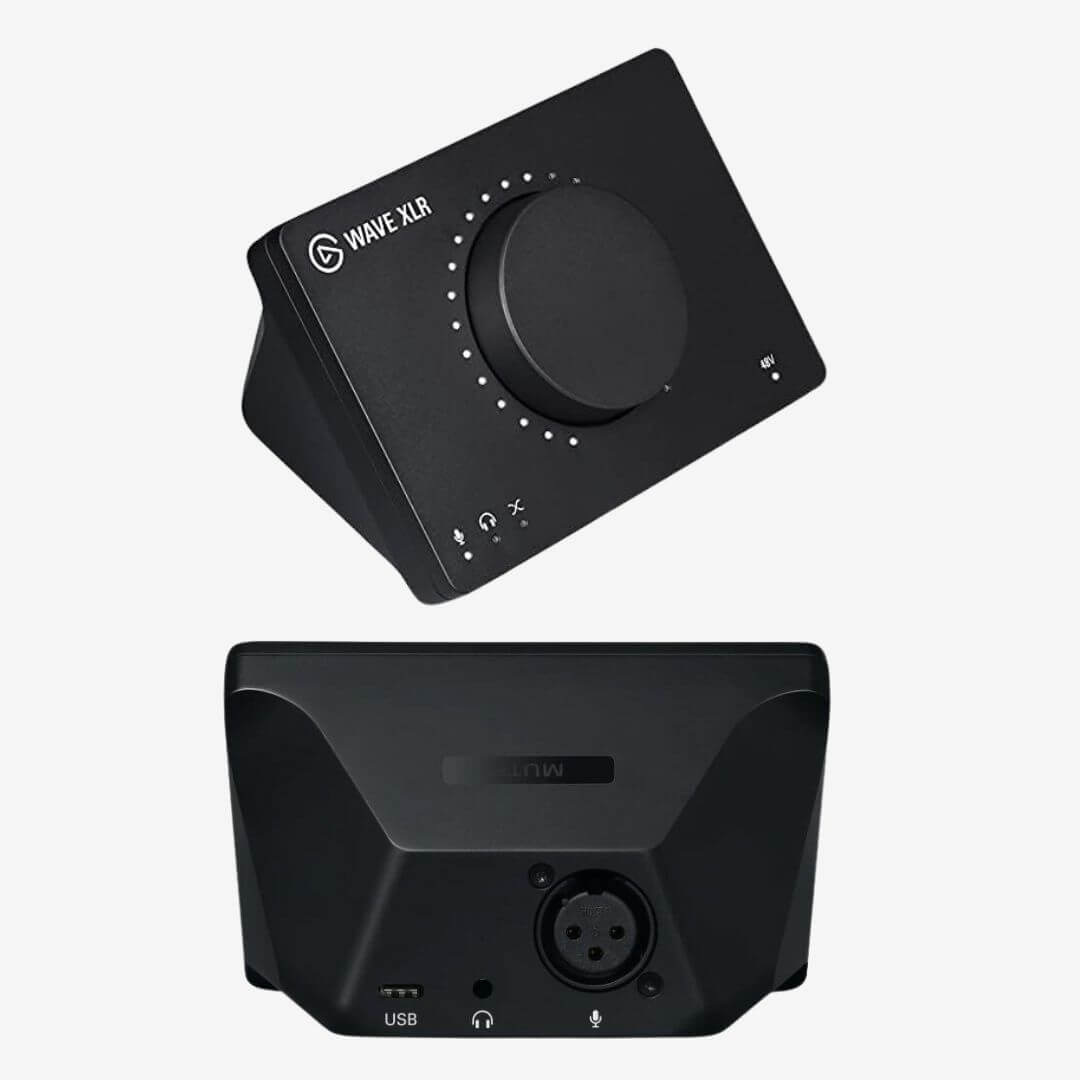
- 1 XLR input
- Dedicated control knob, capacitive sensor
- 96 kHz / 24-bit audio resolution
Another less-known face is the Elgato Wave XLR. With its compact form factor and advanced features, the Wave XLR streamlines your workflow and enhances your audio production capabilities. There may be no connectivity for speakers, but the 3.5mm headphone port optimises the XLR interface for music-making while travelling.
Featuring a singular XLR input on its rear, the device offers a similar design to the Audient ID4 with its multifunctional control knob on its front. A capacitive sensor also sits on the rear, and when coupled with the control knob both provide intuitive control over various parameters, including gain levels and muting.
A significant 75 dB of gain with ultra-low noise and phantom power for condensers are both available, and the Wave XLR ensures crystal-clear audio reproduction with up to 96 kHz / 24-bit digital audio.
Elgato’s Clipguard technology protects against clipping hot signals, as you may expect with such a name, although gain staging is still very much a good idea! The Wave XLR Moreover integrates with Wave Link mixing software, offering real-time control over multiple input channels and the ability to create independent output mixes for different applications and deliverables.
Additionally, the Wave XLR boasts a swappable faceplate design, allowing users to customize the look of their interface to suit their preferences. With its advanced features and user-friendly design, the Elgato Wave XLR is a powerful tool for music producers, podcasters, and home-recording artists seeking professional-grade audio performance.
M-Audio M-Track Solo – $50 – affordable computer audio interface
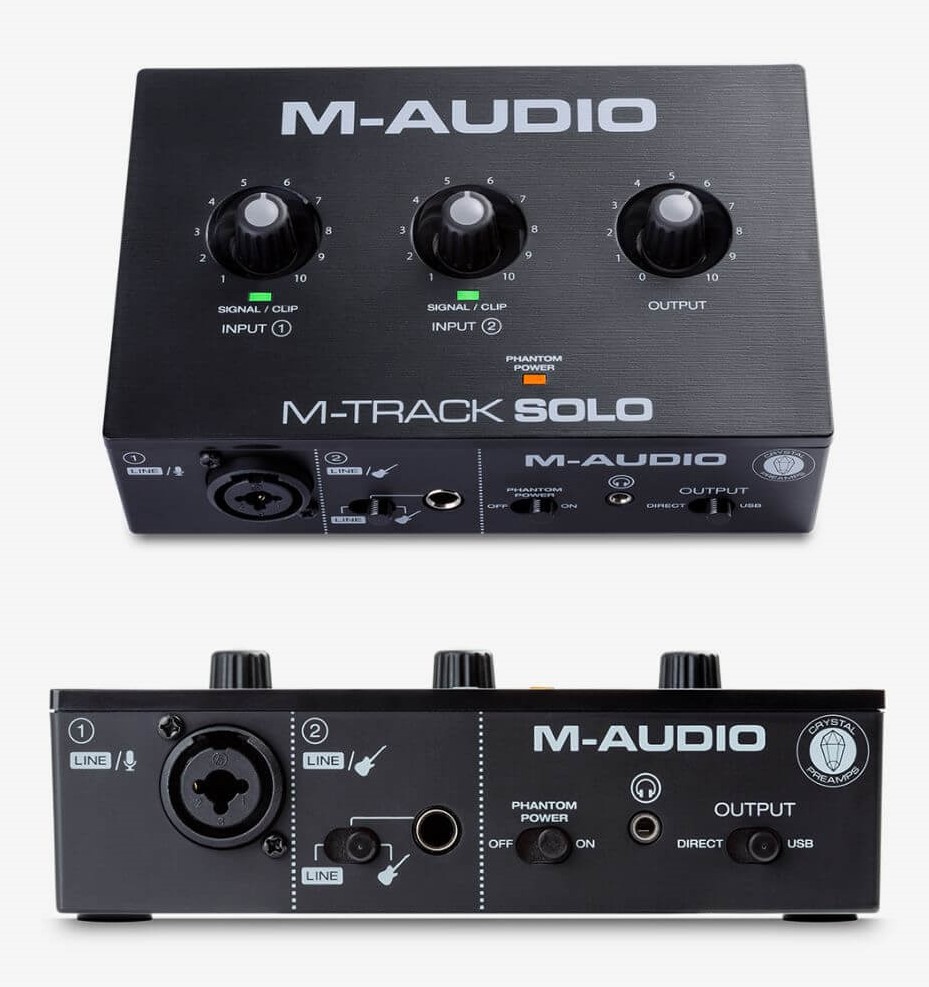
- 2 in / 2 out
- 16-bit/48 kHz
- Crystal Preamp
The infamous M-Audio M-Track Solo stands as a premier choice for producers and recording artists seeking a compact, user-friendly digital recording solution at an ultra-affordable price tag.
At 16-bit/48 kHz, the M-Track Solo provides plenty of resolution for rich recordings. Featuring M-Audio’s Crystal Preamps, pristine A/D converters, and premium components, this interface captures every nuance of your performance with unparalleled clarity and fidelity, making it an indispensable tool for aspiring and seasoned producers.
However, using both line inputs simultaneously makes for great stereo recording of line instruments like digital pianos or capturing multiple electric guitars. A 3.5mm headphone jack provides zero-latency monitoring.
Powered solely by USB, the M-Track Solo is compact and fully portable for on-the-go recording. Bundled with a comprehensive software package, including MPC Beats and 80 effect plugins provided by AIR, the M-Track Solo empowers you to create something cool immediately. It even comes with world-class virtual instruments like TubeSynth, Electric, and Bassline.
EVO Audient 8 USB – $230
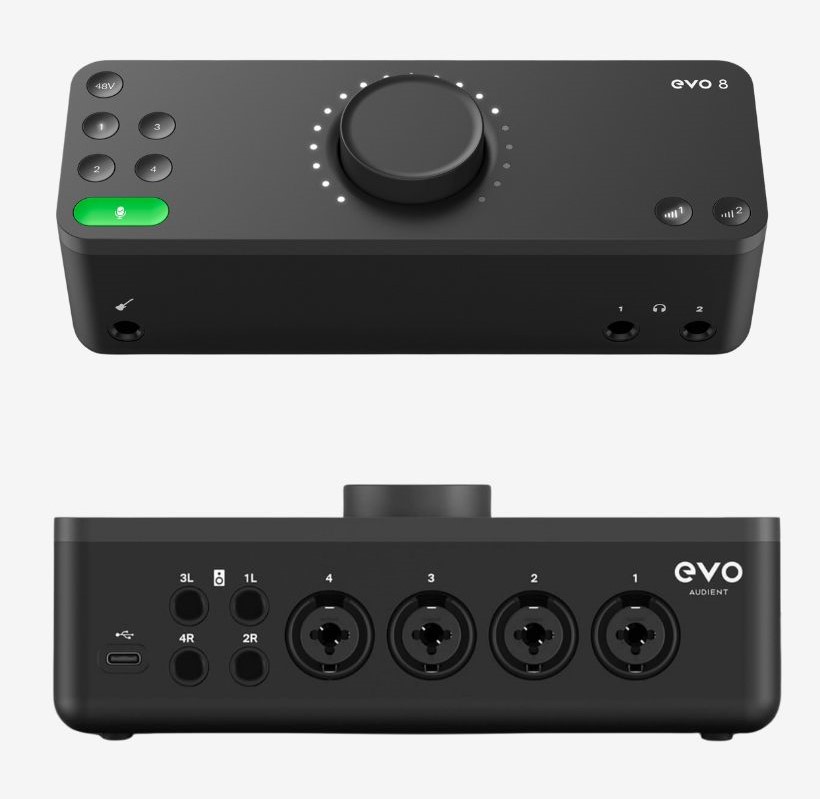
- 4 in / 4 out
- 24-bit/ 96Khz recording
- SmartGain
The Evo 8 is definitely on the high end of “affordable”, but it’s here because 2 inputs may not be enough – especially if you’re a drummer.
The bigger Audient EVO 8 offers four of the same award-winning EVO Mic preamps and class-leading converters, and it’s backed by the same 25 years of engineering experience. It provides the same professional-grade features, easy portability and powerful audio processing capabilities in a bigger package.
Designed for home, on-the-go, and studio recording over USB-C bus power and 4 TRS / XLR combo inputs, the EVO 8 promises a seamless user experience with 4 XLR / JFET instrument combo inputs.Its four Evo preamps offer 58dB of input gain with ultra-low noise & distortion while 113dB of dynamic range provides plenty of headroom for electric & acoustic instrument recording.
The EVO 8’s user-friendly design also includes Smart Touchpoints which allow control over speakers, headphones, and channels with a single encoder. Switchable +48V phantom power is available for each channel, there’s a customizable software mixer for ultra-low latency monitoring and loop-back for podcasting and streaming.
Final thoughts
I know what you’re probably thinking… no Focusrite or Arturia interfaces?!
Both of these brands make affordable audio interfaces that offer stellar performance and both very much deserve to be on this list. The Focusrite Scarlett Solo & Arturia MiniFuse audio interface are worth checking out if you haven’t already, but they’re not on our list because… well, they’re on everyone’s list.
Lesser-known interfaces like the Elgato Wave XLR & AI2 interface from SubZero also deserve mention, and I sacrificed the aforementioned interfaces for this reason. Don’t forget to let us know what affordable interface you’ve chosen in the comments!
